|
Today in New Orleans History |
|
|
September 25


 To receive an update for each day in New Orleans history,
join our facebook page - Today in New
Orleans History.
Oswald Leaves New Orleans In 1963 Lee Harvey Oswald, his wife Marina, and their daughter June lived in the rear
of the right half of this double at 4907 Magazine Street, On September 25, 1963, Lee Harvey Oswald
collected his unemployment check of $33 from the William B. Reily Coffee Company. He had been fired on July 19 "...because
his work was not satisfactory and because he spent too much time loitering in Adrian Alba's garage next door (at 618 Magazine
Street), where he read rifle and hunting magazines." Later that day he caught a bus bound for Houston. According
to his landlord, Mrs. J. J. Garner, he owed about 15 days rent and according to his landlady "All he left was an empty
carton of beer cans". (From http://en.wikipedia.org/wiki/Lee_Harvey_Oswald)  To receive an update for each day in New Orleans
history, join our facebook page
- Today in New Orleans History
In 1943 Ellis Louis Marsalis Sr. converted a chicken barn at 110
Shrewsbury Road at the river (across the street from what is now The Rivershack) into the 40-room Marsalis' Motel complete
with a swimming pool, restaurant, and lounge. Also known as Marsalis Mansion, and Marsalis Tourist Home, from 1943 to
1986 it was one of the only motels open to African Americans traveling to New Orleans. Reverend Martin Luther King Jr.,
Congressman Adam Clayton Powell Jr., future Supreme Court Justice Thurgood Marshall, Ray Charles, and other prominent
civil rights activists, politicians, and musicians stayed there along with thousands of lesser known Black travelers. Marsalis was, himself, active in promoting equal rights in his community and served
as president of the Nationwide Hotel Association. In 1933, he married Florence Robertson, whom he had met while
enrolled in night school. They had two children, .Yvette Washington and Ellis Jr. In 1936, Ellis Sr.
and William Wicker's Esso gas station at Eighth Street and Howard Avenue was the first African American-owned station in the
area. While managing the hotel he promoted positive change
in the community by organizing the Boosters Club, which registered African American voters throughout New Orleans. He
was an active member of the local Republican Party who was elected in 1967
(the year he also expanded the motel and added The Broaster House restaurant to it) to serve on the Republican Executive Committee
and served as its treasurer. He wasa delegate to The Republican Presidential Convention of 1964. .In
1969 he was a a member of the Advisory Committee of the Social Welfare Planning Council. He assisted David Treen's successful 1982 campaign for Louisiana
Governor. . He helped finance the education of Ernest Nathan Morial
("Dutch"), the first Black student to attend the Louisiana State University Law School,
and who became the first Black mayor of New Orleans. Marsalis also played a role in the election of Judge Lionel Collins,
the first Black Judge of the 24th Judicial District Court, in Gretna, Louisiana. His daughter Yvette Marsalis Washington helped him run the motel after her mother's death in 1973.
Ellis Jr. become an excellent jazz pianist and music professor who mentored gifted young New Orleans musicians including Harry
Connick Jr.. His grandsons trumpeter Wynton, saxophonist Branford,
trombonist Delfeayo, and drummer Jason are renowned musicians. The achievements earned by Ellis Marsalis and like-minded civil rights activists led to the demise of the hotel --
which was no longer needed as a haven for black travellers. Marsalis's Mansion Motel closed on September 25, 1986,
demolished in July 1993, and its property sold in July 2006. It remains an empty lot across the street from The Rivershack.
Sculptor Angela Gregory is Nationally Recognized Sculptor Angela Gregory was born in New Orleans on October 18, 1903. Strongly influenced
by her mother, Selina Bres Gregory, who was an early Newcomb potter who studied
at Newcomb College with
William Woodward and Ellsworth Woodward, Angela was also a student of Ellsworth Woodward and she graduated from Newcomb in
1925 with a Bachelor of Arts in design. She became one of the few women of her era to be recognized nationally in a
field generally dominated by men. Her first major commission was at the age of 25 and was for the architectural sculpture
on the façade of the New Orleans Criminal District
Courts Building. Upon completion, news reached as far as New York; the headline
in the September 25, 1930 issue of the New York Sun read: "Prison Walls Made Less Grim by Girl Sculptor, Who at 25 Executes
Many Important Commissions". In 1931, Gregory worked on a team of sculptors who executed historical panels for
the façade of a new state capitol building in Baton
Rouge built during the administrations of Governor Huey Long. Other work from
this period includes a head of Aesculapius on the Hutchinson Memorial Building in Tulane Medical Center, sculpture for Tulane
University’s McAlister Auditorium and many portrait busts. From 1934 to 1937 she returned Newcomb College to teach ceramics
and later was an artist-in-residence and sculpture professor there. Gregory was involved in federal arts programs during
the Depression. As part of that work, she created a monumental bust of John McDonoughthat was installed in City Hall's Duncan Plaza. In 1941, she became state supervisor of the Federal
Works Progress Administration arts program in Louisiana. During World War II she served as an assistant architectural engineer
for the Army Corps of Engineers in New Orleans and designed camouflage. Later in that time period she served as women’s counselor for
Pendleton Shipyards, and as a consultant to the Celotex Corporation. After the war she returned to sculpture. Commissions
included bas-relief murals
for the Louisiana National Bank in Baton Rouge. She also restored sculptures on New Orleans’ Gallier Hall. In
the 1950s, she devoted five years to the creation and casting of the bronze Bienville Monument, which stood outside the New
Orleans train station on Loyola Avenue for many years. It now stands in a small park near the French Quarter, at the intersection of Decatur and Conti Streets. The monument portrays the first French governor and founder of New Orleans, a priest, and an Indian. Gregory spent
two years in France supervising the casting of the monument. Gregory was a professor and sculptor-in-residence for two decades
at the St. Mary’s Dominican College in New Orleans, and was named professor emerita when she retired in 1976. During her years at Dominican, she
created a series of aluminum and walnut panels tracing the life of Pope John XXIII at the Dominican College library. Other
work of that era included a statue of St. Louis for the Archdiocese of New Orleans’ Notre Dame Seminary, and a statue
of St. Fiacre in
the garden of Christ Church Cathedral. In the early 1960s, she sculpted the monument to Henry Watkins Allen in Port Allen, Louisiana. Gregory is often credited with being one of the few women sculptors of her era to complete
three public monuments. Gregory’s Pine Street studio was a “meeting place for musicians, diplomats, distinguished
guests from France, writers like close friend Thornton Wilder, and actors like Kirk Douglas, whose wedding reception was in
her studio.” She died in New Orleans on February
13, 1990. During his twenty-two-year tenure as Superintendent of New Orleans Public Schools,
Warren Easton launched classes in calisthenics, drawing, and music. He submitted the first typewritten superintendent's
report on January 11, 1889. On November 2, 1905, forty
young men enrolled in public schools' first short-hand, typing class. On October 15, 1894 Easton inaugurated fire drills in schools, and on September 25, 1906 he required compulsory smallpox vaccinations of students.
The Long and Winding Road Back Home to the Dome On October 21, 2005, Benson
issued a statement saying that he had not made any decision about the future of the Saints. The San Antonio Express-News
reported that sources close to the Saints' organization said that Benson planned to void his lease agreement with New Orleans
by declaring the Louisiana Superdome unusable. NFL
Commissioner Paul Tagliabue met with Benson and Louisiana governor Kathleen Blanco at the Saints' first home game in Baton
Rouge on October 30 against the Miami Dolphins. After the meeting Tagliabue said "The Saints are Louisiana's team and
have been since the late '60s when my predecessor Pete Rozelle welcomed them to the league as New Orleans' team and Louisiana's
team. Our focus continues to be on having the Saints in Louisiana." He dispelled rumors that had the Saints relocating
to Los Angeles. Tagliabue appointed an eight-owner advisory committee to help decide the team's future. Benson left the game
with five minutes left in the fourth quarter. A WWL-TV camera crew recorded him leaving the stadium. Benson angrily pushed
the camera away and then got into an argument with a fan. Three days later, Benson issued a statement that he would no longer
go to Baton Rouge for Saints home games because he felt he and his family were in danger from abuse at the game. The
following day, Benson agreed with Louisiana state officials to extend his opt out clause with the Superdome and Louisiana
until January 2007. In the midst of the Katrina relocation controversy, several groups of investors approached Benson
with offers to buy the team and keep them in Louisiana, the most notable group being one led by Fox Sports analyst and former
Pittsburgh Steelers quarterback Terry Bradshaw, who is a Louisiana native. Benson expressed that he had no intention of selling
the team and planned to eventually hand down ownership to his granddaughter, Saints owner/executive Rita Benson LeBlanc. Benson
spoke to press following an NFL owners' meeting on November 15, during which he reiterated that the team is not for sale,
but also stated that other NFL owners, along with Tagliabue, were working with him to keep the team in New Orleans. Tagliabue said the team's preseason games would likely be played elsewhere in the region. He also
stated that the Saints and the NFL were committed to New Orleans for the long haul. Starting in the fall of 2006, the
Saints returned to playing all of their regular home games of the 2006 season in New Orleans at the Superdome. Their first
game back in New Orleans, on September 25, 2006, was marked by a dramatic blocked punt early in the first quarter, with Steve
Gleason blocking the punt and Curtis Deloatch recovering the ball in the Falcons' end zone for a touchdown. It was the first
score in the Saints' first game in New Orleans in nearly 21 months. The Saints won the game and, unexpectedly, went on to
have the most successful season in their history up to that time, reaching the NFC Championship Game for the first time in
franchise history. |
|
|

To receive an update for each day in New Orleans history,
join our facebook page - Today in New
Orleans History.
Analytics |
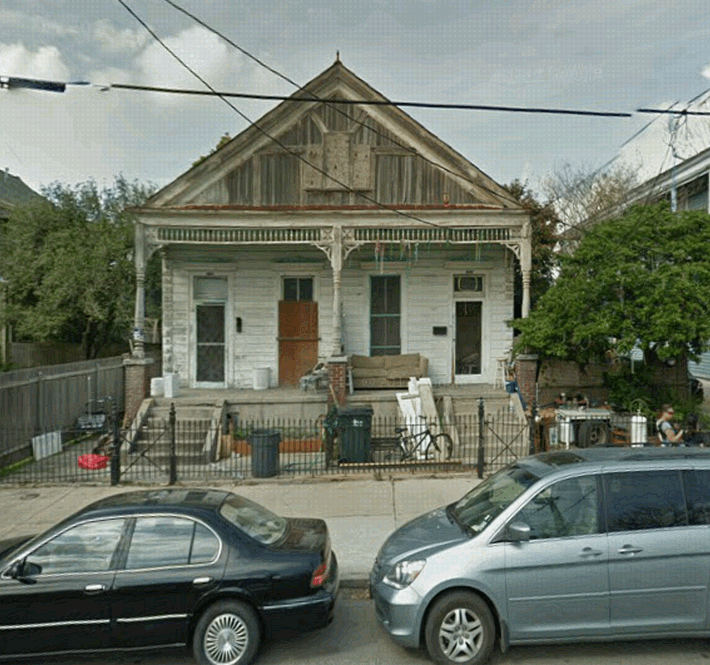
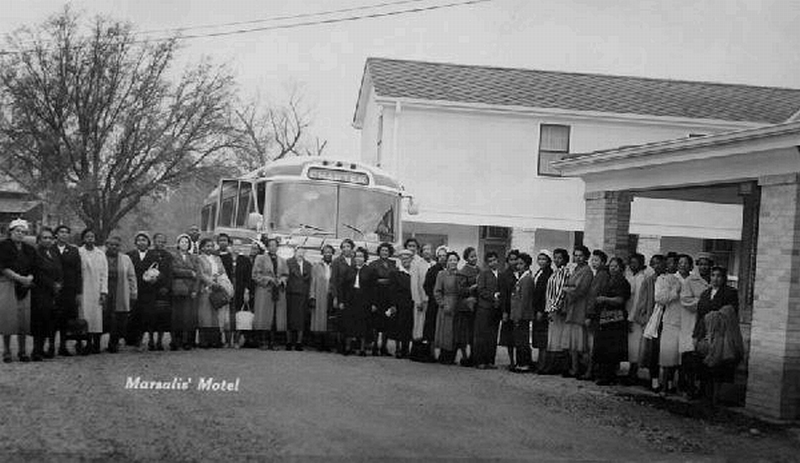
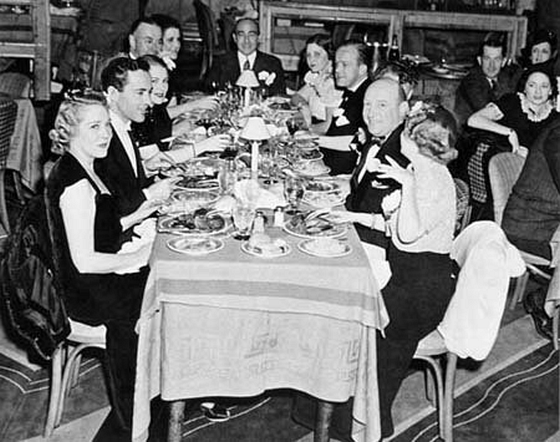
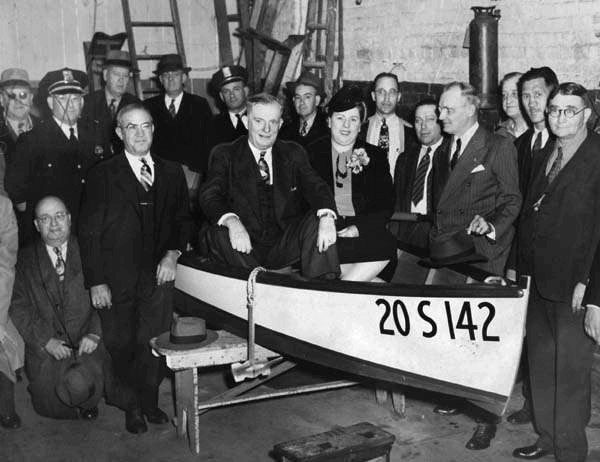 "Superintendent and Mrs. George Reyer pose in the skiff which was presented to Chief Reyer as a Christmas present by
members of the 'Two-Bit Club', December 26, 1944. Reyer is shown surrounded by leading police figures and friends."
The photograph was taken in the police automobile repair shop at the corner of South White and Gravier Streets.
"Superintendent and Mrs. George Reyer pose in the skiff which was presented to Chief Reyer as a Christmas present by
members of the 'Two-Bit Club', December 26, 1944. Reyer is shown surrounded by leading police figures and friends."
The photograph was taken in the police automobile repair shop at the corner of South White and Gravier Streets.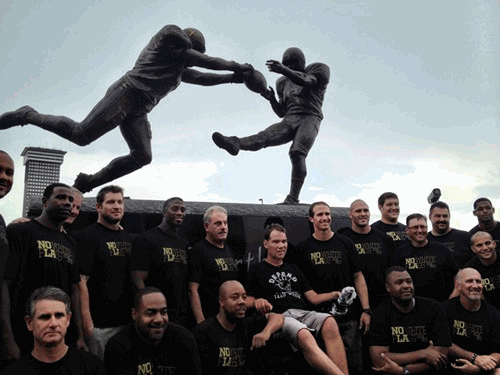
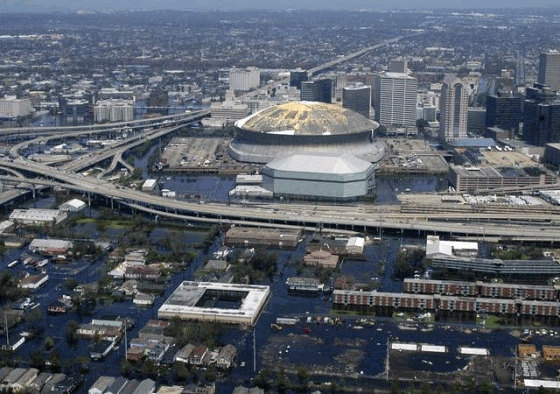 The road back to the Dome post-Katrina was filled with controversy, innuendo, and rumor. Did owner Tom Benson want to
move the team to San Antonio? Did the NFL prefer to relocate the Saints to Los Angeles, or even to expand to Toronto
-- both cities over twice the size of San Antonio?
The road back to the Dome post-Katrina was filled with controversy, innuendo, and rumor. Did owner Tom Benson want to
move the team to San Antonio? Did the NFL prefer to relocate the Saints to Los Angeles, or even to expand to Toronto
-- both cities over twice the size of San Antonio?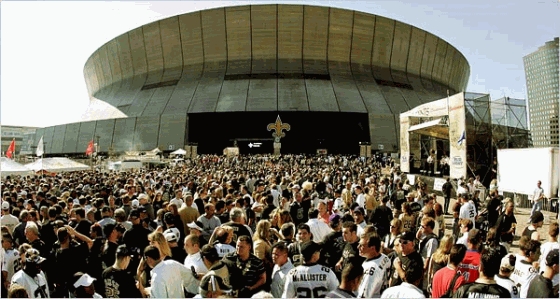 On December 5, Tagliabue met with Benson and New Orleans officials to tour the city and assess the viability of playing in
New Orleans in 2006. On January 11, 2006, at a press conference in New Orleans, Tagliabue announced that the Saints would
likely play all eight home games at the Superdome. Superdome officials said January 12 that the Dome would be ready by September
1, 2006. The NFL announced on February 5, 2006, that the Superdome would reopen on September 24 when the Saints were to host
the Atlanta Falcons.
On December 5, Tagliabue met with Benson and New Orleans officials to tour the city and assess the viability of playing in
New Orleans in 2006. On January 11, 2006, at a press conference in New Orleans, Tagliabue announced that the Saints would
likely play all eight home games at the Superdome. Superdome officials said January 12 that the Dome would be ready by September
1, 2006. The NFL announced on February 5, 2006, that the Superdome would reopen on September 24 when the Saints were to host
the Atlanta Falcons.
